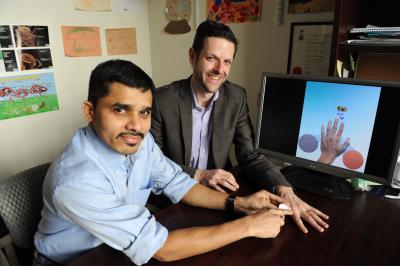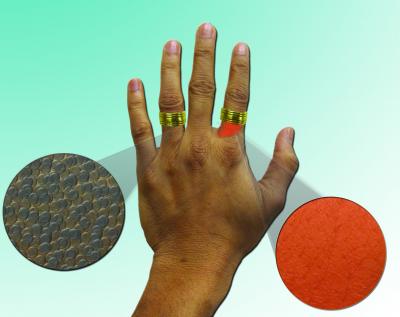Tiny particles only billionths of a meter in diameter—about two thousand would fit across the width of a human hair—could offer big hope in a small package to the many millions of people who are allergic to the nickel in everything from jewelry to coins and cell phones, says scientists at Brigham and Women’s Hospital and Harvard Medical School.
In the April 3 online issue of Nature Nanotechnology, the team reported a new approach to preventing the common skin allergy.

Approximately 10 to 15 percent of the U.S. population, or more than 30 to 45 million people, plus many more worldwide, are allergic to the nickel found in many everyday objects. When it comes into contact with their skin, the metal causes a red, itchy rash. You can see many examples through a quick google search for nickel-induced dermatitis.
However, even though some countries regulate the amount of the metal in certain products to limit exposure, there is no good solution to the problem. “There have been approaches to developing creams with agents that bind the nickel before it can penetrate the skin, but these are not effective in most patients and can even be toxic when the agents themselves penetrate the skin, as most do,” said team leader Jeffrey Karp, HMS assistant professor of medicine and co-director of the Center for Regenerative Therapeutics at Brigham and Women’s.
“People also sometimes coat their jewelry with nail polish to create a barrier between the skin and nickel ions,” he said. “But this won’t prevent all exposures, such as handling coins or wearing a watch.”
Karp, who also holds appointments through the Harvard Stem Cell Institute and the Harvard-MIT Division of Health Sciences and Technology, is himself allergic to nickel.
Now he and colleagues including R. Rox Anderson, HMS professor of dermatology at Massachusetts General Hospital, have found that nanoparticles containing calcium could offer a safe solution to the problem. When applied to the skin in a cream, the nanoparticles efficiently capture the nickel, preventing it from making its way into the body. Further, the nanoparticles themselves were designed so that they cannot penetrate the skin. The cream with its nickel can then be easily washed off with water.

“Despite barrier creams, anti-inflammatory drugs, and attempts to avoid nickel, this [metal] is still the most common cause of allergic skin reactions,” Anderson said. “Nanoparticles that bind to [the nickel] allergens but do not penetrate the skin offer a new strategy. Big hope in a small package!”
“We expect that a person could simply apply the cream just as they would hand cream,” said Praveen Kumar Vemula, a research fellow in medicine at BWH and first author of the paper.
The idea for tackling the problem began when Karp, a specialist on nanoparticles, met Anderson at a dinner. Afterward, Karp sat at his computer thinking about how he could potentially work with the accomplished dermatologist to tackle medical problems. As he pondered, he looked at his hands, which were red and itchy from his nickel allergy. Could he and Anderson find a nontoxic, practical way to prevent nickel from penetrating the skin using nanoparticles?
The team began by focusing on compounds containing calcium, which are known to sequester nickel (some are used in the treatment of water). Next, they explored whether these compounds were available as nanoparticles. Karp knew that the tiny particles could potentially allow very efficient nickel capture thanks to their very high surface area.
The team limited their search to nanoparticles within a certain size range. “We wanted them to be large enough so they could not penetrate the skin,” Vemula said, “yet small enough to present a very large surface area for capturing nickel.” (They ultimately decided on particles between 70 and 500 nanometers.) Finally, to cut the time involved in bringing a new technology to market, the team only explored nanoparticles already designated by the Food and Drug Administration as being generally recognized as safe for use in humans.
They found two compounds that met these criteria, calcium carbonate and calcium phosphate, added them to a common emollient to create a cream and tested them under a variety of experimental conditions. For example, they applied the cream to samples of animal skin and to living animals, and tested it in the presence of artificial sweat (sweat is known to exacerbate the allergy, accelerating the release of nickel). Further, they conducted the tests with concentrations of nickel much higher than would be found in everyday situations.
“We were able to demonstrate that the particles could indeed capture nickel with high efficiency and prevent inflammation in nickel-sensitized animals,” Karp said. Further, “we needed 11-fold less nanoparticles to get the same effect” as another common nickel-capture agent. (A significant drawback of the latter: it can penetrate the skin, and even small amounts can cause local and systemic toxicity.)
All results “suggest that nanoparticles can effectively prevent the penetration of nickel into the skin, and may therefore abrogate nickel-induced contact dermatitis,” the team concluded in the Nature Nanotechnology paper.
The team has a patent on the work, which was funded by Brigham and Women’s Hospital. Vemula is a recipient of an entrepreneur postdoctoral fellowship from the Ewing Marion Kauffman Foundation.
To learn more, students may e-mail Jeffrey Karp, HMS assistant professor of medicine at BWH and and in the Harvard-MIT Division of Health Science and Technology at jeffkarp@mit.edu.
The authors declare no competing financial interests.


